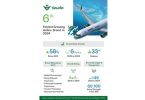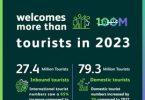A new National Park Service (NPS) report shows that 4.8 million visitors to national parks in Hawaii spent $526 million in the state in 2018. That spending resulted in 5,800 jobs and had a cumulative benefit to the state economy of $734 million.
“The national parks of Hawaii attract visitors from across the country and around the world,” said Stan Austin, regional director for the Pacific West Region. “Whether they are out for an afternoon, a school field trip, or a month-long family vacation, visitors come to have a great experience, and end up spending a little money along the way. This new report shows that national park tourism is a significant driver in the national economy – returning $10 for every $1 invested in the National Park Service, a result we can all support.”
The national parks in Hawaii are:
-
Ala Kahakai National Historic Trail
-
Haleakala National Park
-
Hawaii Volcanoes National Park
-
Honouliuli Historic Site
-
Kalaupapa National Historical Park
-
Kaloko-Honokohau National Historical Park
-
Pearl Harbor National Memorial
-
Pu`uhonua O Honaunau National Historical Park
-
Pu’ukohola Heiau National Historic Site
The peer-reviewed visitor spending analysis was conducted by economists Catherine Cullinane Thomas and Egan Cornachione of the U.S. Geological Survey and Lynne Koontz of the National Park Service. The report shows $20.2 billion of direct spending by more than 318 million park visitors in communities within 60 miles of a national park. This spending supported 329,000 jobs nationally; 268,000 of those jobs are found in these gateway communities. The cumulative benefit to the U.S. economy was $40.1 billion.
Lodging expenses account for the largest share of visitor spending, about $6.8 billion in 2018. Food expenses are the second largest spending area and visitors spent $4 billion in restaurants and bars and another $1.4 billion at grocery and convenience stores.
Visitor spending on lodging supported more than 58,000 jobs and more than 61,000 jobs in restaurants. Visitor spending in the recreation industries supported more than 28,000 jobs and spending in retail supported more than 20,000 jobs.
Report authors also produce an interactive tool that enables users to explore visitor spending, jobs, labor income, value added, and output effects by sector for national, state, and local economies. Users can also view year-by-year trend data. The interactive tool and report are available at the NPS Social Science Program webpage: https://www.nps.gov/subjects/socialscience/vse.htm
To learn more about national parks in Hawaii and how the National Park Service works with Hawaiian communities to help preserve local history, conserve the environment, and provide outdoor recreation, go to https://www.nps.gov/state/hi.























